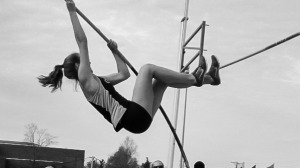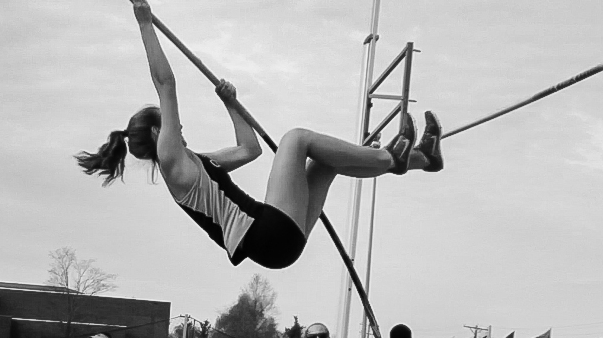By MASON McCLAY – CENTO WRITER
Let’s face it, the ability to fly is something we all long to have. Ask anyone for his/her most-preferred, classic superpower and the answer will understandably be, “I wish I could fly!”
Unfortunately, unlike the potential opportunity of being bitten by a radioactive spider to grant you web-slinging powers, or being a product of an experimental disaster that gives you extraordinary strength, there has been little scientific progress in obtaining the ability to fly. Very sad. However, some of you may have even experienced this sensation, or at least something close to it.
Welcome to the world of pole-vaulting — the cheapest way to get into the four-meter-high club.
As it is clear that pole-vaulting is the greatest means of flight, I had an incredible idea — I would attempt to pole-vault. But to avoid fatal injury I first thought it would be best to talk with experts in the field to learn the best pole-vaulting secrets, including techniques, rituals, diet — hopefully everything I needed to know to be airborne.

In order to empirically test the advice I was given, I figured I would take ten points that seemed to be the most helpful from three different pole-vaulters and practice one piece of advice at a time whilst vaulting. In the end, the experience was one of passion and persistence. Now, here are the results:
Attempt # 1) Advice: “You’re more likely to get hurt if you jump scared,” senior Michael Orr said. At first I thought, “Excellent advice! Fear is obviously my biggest enemy.” But perhaps this advice is for veteran vaulters. I put on my fearless face and nearly concussed myself (and others).
Attempt # 2) Advice: “Ibuprofen is a way of life. The last time anyone competed without it was maybe never,” sophomore Mikayla Paolini said. Given my initial attempt, painkillers were obviously needed. Unfortunately their effects include delayed reaction time. I ended up going up, and coming down, on my back.
Attempt # 3) Advice: “[Believing in superstition] is a no-fail system because [vaulters] are incapable of changing only one variable at a time. ‘Oh, you wore a ribbon this week and had a green sports bra? Well, you did better last week when you tucked your laces into your spikes on the left side and wore your hair in a bun,’” Paolini said. Well, with a lack of ribbons and sports bras, I tried my best to use this advice with any number of ridiculously colorful socks. The conclusion? My approach was better, and I think I ran faster, but overall I just felt more ignorant.
Attempt # 4) Advice: “Having perfect body weight distribution is really important. So is eating six desserts in Cowan on any given night,” Paolini said. At this point, I needed just a slight morale boost. So, I adopted a more creative approach that allowed for an interesting interpretation of this advice. I made weighted pants that served to fix this problem. And the results were conclusive: I made it over the bar.
Attempt # 5) Advice: “Build up core strength to get a strong swing-up phase,” Orr said. Since my core strength is already perfect, I considered this advice simply because it made me feel better about myself. The jump itself was a fail, however.
Attempt # 6) Advice: “Find the equilibrium of strength-per-pound,” first-year Stephen Orr said. I calculated that to most effectively be able to propel myself from a pole, I needed about 180 Newtons of force. Now that’s about one Newton per-pound of body mass. Unbeknownst to me, I am much stronger than that. This advice helped me stabilize my jumps by trying less.
Attempt # 7) Advice: “The event appeals to a really bizarre group of people,” Paolini said. Well, I’ll fit right in. This secret point of advice boosted my confidence significantly, and after the prior six attempts, the advice from attempt number one (fearlessness) began to bear some truth.
Attempt # 8) Advice: “Pole-vaulters are sometimes like that angst-y middle child — the one who insists that while everyone can appreciate their event no one will ever truly appreciate it,” Paolini said. As a middle child, I thought that this was more of a point of contemplation. I closed my eyes before vaulting, looked into the eyes of neglected, younger Mason, and told him to suck it up. Surprisingly, it worked pretty well. Two for eight.
Attempt # 9) Advice: “You have to be comfortable being upside down,” [Michael] Orr said. Unbeknownst to most people, I suffer from a disease known as invertigo, commonly known as bat syndrome. It gives me an insatiable desire to be upside down. I harnessed the full potential of my invertigo for this attempt, but went upside down a little too early. Synopsis: two chipped teeth.
Attempt # 10) Advice: “Sometimes it’s just about looking at that pole and saying, ‘Hey dude, let’s party,’” just like someone once said. For my final attempt to make it over the bar, this wise adage was taken wholeheartedly. This one last attempt was the dance, and the pole was the object of my affection. In an elaborate array of fluent motions, and through my most powerful plant yet, I soared well above the bar.
I was finally airborne.
